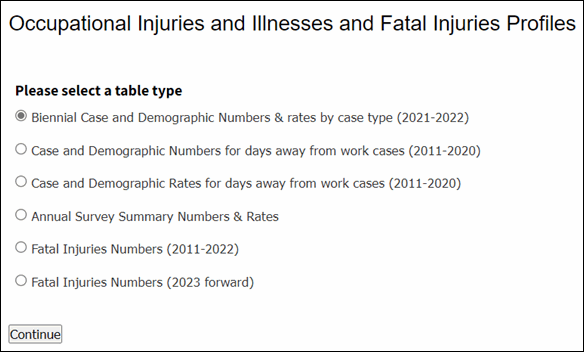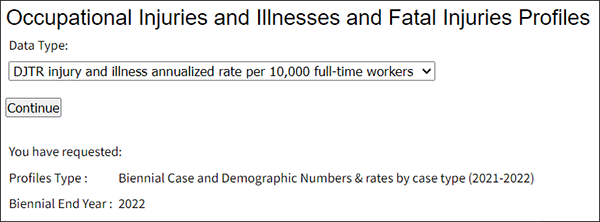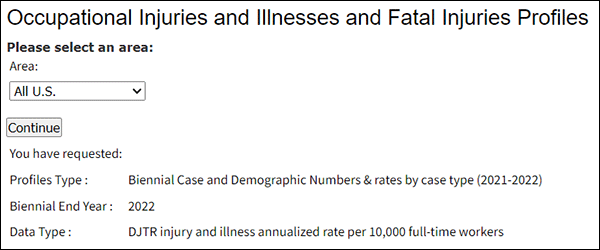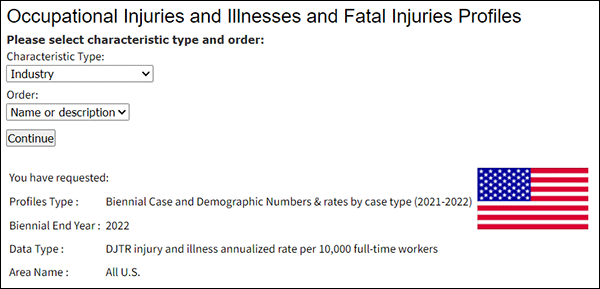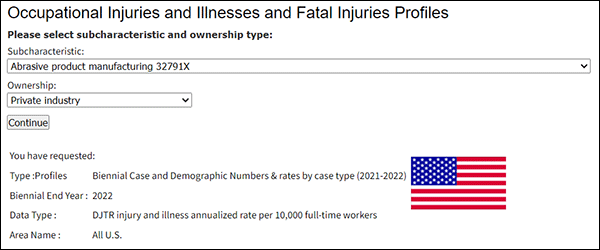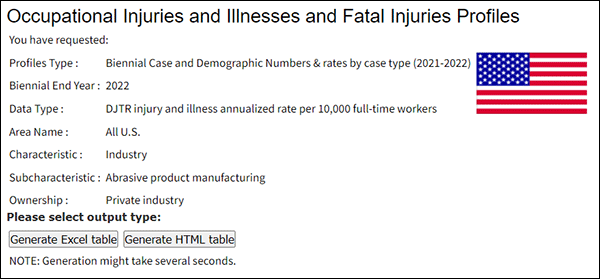Welcome to the step-by-step guide on how to use the Occupational Illnesses and Injuries Profiles tool
Table Types
There are six table types:
- Biennial Case and Demographic Numbers & rates by case type (2021-2022) will provide biennial weighted estimates for case numbers, annualized incidence rates, and median days of job transfer, restriction, or days away from work due to workplace injuries and illnesses for the characteristic selected. Estimates will be provided for gender, age group, major occupational group, length of service with the employer, race or ethnic origin, number of days by case type group, industry sectors, nature of the injury or illness, part of body affected, source of the injury or illness, event or exposure, time of day, hours on the job, and day of week. These data are released biennially (every 2 years) and reflect a two-year reference period for example reference years 2021-2022.
- Case and Demographic Numbers for days away from work cases (2011-2020) will provide weighted estimates of the number of occupational injuries and illnesses resulting in days away from work for the characteristic selected. Estimates will be provided for gender, age group, major occupational group, length of service with the employer, race or ethnic origin, number of days away from work including median days, industry sectors, nature of the injury or illness, part of body affected, source of the injury or illness, event or exposure, time of day, hours on the job, and day of week. These data are represented for a single reference year.
- Case and Demographic Rates for days away from work cases (2011-2020) will provide incidence rates of the number of occupational injuries and illnesses resulting in days away from work for the characteristic selected. Incidence rates will be provided for number of days away from work, industry sectors, nature of the injury or illness, part of body affected, source of the injury or illness, and event or exposure. These data are represented for a single reference year.
- Annual Survey Summary Numbers and Rates will provide weighted estimates and incidence rates for occupational injuries and illnesses for the industry selected and for all industries. Estimates and rates will be provided for total cases; cases with days away from work, job transfer or restriction; cases with days away from work; cases with job transfer of restriction; other recordable cases; injuries only; illnesses only; and specific illness categories.
- Fatal Injuries Numbers (2011-2022) profile will provide the number of fatal occupational injuries for the characteristic selected. Counts will be provided for employee status (whether the employee was self-employed or not), gender, age group, race or ethnic origin, event or exposure, primary source of the injury, secondary source of the injury, nature of the injury, part of body affected, worker activity, location, occupation, and industry.
- Fatal Injuries Numbers (2023 forward) profile will provide the number of fatal occupational injuries for the characteristic selected. Counts will be provided for employee status (whether the employee was self-employed or not), gender, age group, race or ethnic origin, event or exposure, primary source of the injury, secondary source of the injury, nature of the injury, part of body affected, worker activity, location, occupation, and industry.
Year and Biennial end year
A single year can be selected. For the following table types, the year represents the reference period:
- Case and Demographic Numbers for days away from work cases
- Case and Demographic Rates for days away from work cases
- Annual Survey Summary Numbers and Rates
- Fatal Injuries Numbers
For the table type Biennial Case and Demographic Numbers & rates by case type (2021-2022), "Biennial end year" can be selected. The selection indicates the second year of the biennial reference period. For example, if 2022 is selected, then it will return estimates for the 2021-2022 reference period.
Data Type — Biennial case and demographic estimates only
Data type can be selected for the report type Biennial Case and Demographic Numbers & rates by case type (2021-2022) only.
Data type indicates the case type (DJTR, DAFW, or DART) and type of estimate (biennial case numbers, annualized rates, or median days). The selections include:
- DJTR injury and illness annualized rate per 10,000 full-time workers (1)
- DJTR biennial injury and illness cases (2)
- Median days of job transfer or restriction (4)
- DAFW injury and illness annualized rate per 10,000 full-time workers (3)
- DAFW biennial injury and illness cases (6)
- Median days away from work (7)
- DART injury and illness annualized rate per 10,000 full-time workers (5)
- DART biennial injury and illness cases (8)
- Median DART days (9)
Area
Data for all U.S., participating States and territories are available from 1992 onward. State participation in the Survey of Occupational Injuries and Illnesses may vary by year, so the availability of nonfatal state data may vary for some states.
Type and the Order
Characteristic Type refers to industry, occupation, case characteristic, or demographic characteristic. Demographic characteristics and occupations are not available for table type 3. Industry is the only characteristic type available for table type 4.
Order refers to the sort order of the detailed characteristic chosen. "Name or description" is an alphabetic sort. The other option is a numeric sort order.
Subcharacteristic and Ownership Type
Subcharacteristic is the detailed list of choices for the characteristic chosen. For example, if gender was the characteristic chosen, the subcharacteristics would be "male", "female", and "gender not reported".
Ownership type is based on the State selected. Some States that participate in the Survey of Occupational Injuries and Illnesses (SOII), collect data for State and Local Government. If the State chosen covers these ownerships, they will be listed under ownership type. If the State does not cover these ownerships, only "detailed private industry" will be available.
Output Type
The Output types are:
- "Generate Excel table" which will create an Excel file (.xls). You will be prompted to save or open the output.
- "Generate HTML table" which will create an HTML table on screen.
Last Modified Date: December 19, 2024
 United States Department of Labor
United States Department of Labor
